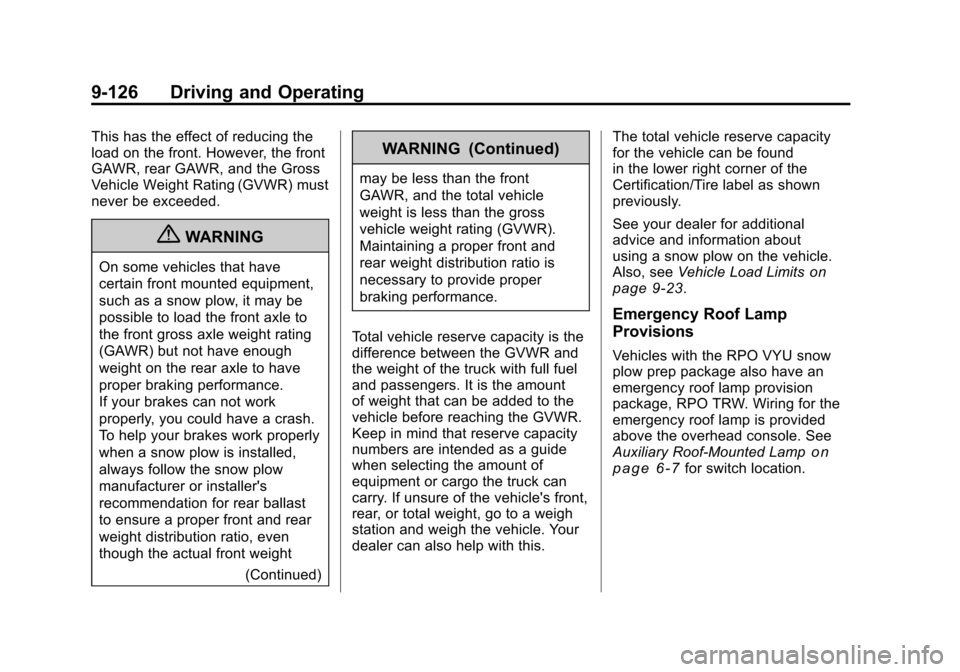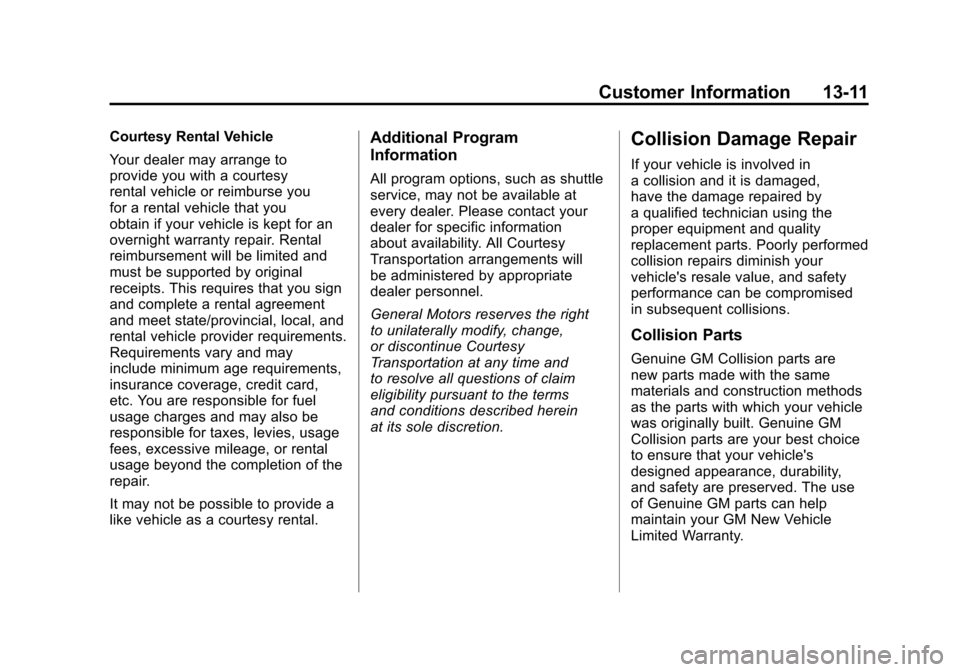2011 CHEVROLET SILVERADO fuel reserve
[x] Cancel search: fuel reservePage 321 of 588

Black plate (27,1)Chevrolet Silverado Owner Manual - 2011
Driving and Operating 9-27
The label shows the size of
your vehicle's original tires
and the inflation pressures
needed to obtain the gross
weight capacity of your vehicle.
This is called Gross Vehicle
Weight Rating (GVWR). The
GVWR includes the weight of
the vehicle, all occupants, fuel,
and cargo.
The Certification/Tire label also
tells you the maximum weights
for the front and rear axles,
called Gross Axle Weight
Rating (GAWR). To find out the
actual loads on your front and
rear axles, you need to go to a
weigh station and weigh your
vehicle. Your dealer can help
you with this. Be sure to spread
out your load equally on both
sides of the centerline.Never exceed the GVWR for
your vehicle, or the GAWR for
either the front or rear axle.
The Certification/Tire label also
contains important information
about your Front Axle Reserve
Capacity. See
“What is front axle
reserve capacity, and how do
I calculate it?” underAdding a
Snow Plow or Similar Equipment
on page 9‑123.
{WARNING
In the case of a sudden stop
or collision, things carried in
the bed of your truck could
shift forward and come into
the passenger area, injuring
you and others. If you put
things in the bed of your truck,
you should make sure they
are properly secured.
{WARNING
Do not load the vehicle any
heavier than the Gross
Vehicle Weight Rating
(GVWR), or either the
maximum front or rear Gross
Axle Weight Rating (GAWR).
If you do, parts on the vehicle
can break, and it can change
the way the vehicle handles.
These could cause you to
lose control and crash. Also,
overloading can shorten the
life of the vehicle.
Notice :Overloading the
vehicle may cause damage.
Repairs would not be covered
by the vehicle warranty.
Do not overload the vehicle.
Page 418 of 588

Black plate (124,1)Chevrolet Silverado Owner Manual - 2011
9-124 Driving and Operating
the weights on the vehicle's
axles and the Gross Vehicle
Weight (GVW), are not exceeded.
The plow the vehicle can carry
depends on many things, such as:
.The options the vehicle came
with, and the weight of those
options.
.The weight and number of
passengers you intend to carry.
.The weight of items added to
the vehicle, like a tool box or
truck cap.
.The total weight of any
additional cargo you intend to
carry.
Say, for example, you have a 318 kg
(700 lb) snow plow. The total weight
of all occupants and cargo inside
the cab should not exceed 135 kg
(300 lb). This means that you may
only be able to carry one passenger.
But, even this may be too much
if you have got other equipment
already adding to the weight of
the vehicle. Here are some guidelines for safely
carrying a snow plow on the vehicle:
.Make sure the weight on the
front and rear axles does not
exceed the axle rating for each.
.For the front axle, if more cargo
or passengers must be carried,
appropriate counter ballast must
be installed rear of the rear axle.
Counter ballast must be properly
secured so it will not move
during driving.
.Follow the snow
plow manufacturer's
recommendations regarding
rear ballast. Rear ballast may
be required to ensure a proper
front and rear weight distribution
ratio, even though the actual
weight at the front axle may be
less than the front axle rating.
.The snow plow manufacturer
or installer can assist you in
determining the amount of rear
ballast required, to help make
sure the snowplow/vehicle
combination does not exceed
the GVW rating, the front and
rear axle ratings, and the front
and rear weight distribution ratio.
.The total vehicle must not
exceed the GVW rating.
Front axle reserve capacity is the
difference between the Gross Axle
Weight Rating (GAWR) and the front
axle weight of the vehicle with full
fuel and passengers. Basically, it is
the amount of weight that can be
added to the front axle before
reaching the front GAWR.
The front axle reserve capacity
for the vehicle can be found
in the lower right corner of the
Certification/Tire label, as shown.
Page 420 of 588

Black plate (126,1)Chevrolet Silverado Owner Manual - 2011
9-126 Driving and Operating
This has the effect of reducing the
load on the front. However, the front
GAWR, rear GAWR, and the Gross
Vehicle Weight Rating (GVWR) must
never be exceeded.
{WARNING
On some vehicles that have
certain front mounted equipment,
such as a snow plow, it may be
possible to load the front axle to
the front gross axle weight rating
(GAWR) but not have enough
weight on the rear axle to have
proper braking performance.
If your brakes can not work
properly, you could have a crash.
To help your brakes work properly
when a snow plow is installed,
always follow the snow plow
manufacturer or installer's
recommendation for rear ballast
to ensure a proper front and rear
weight distribution ratio, even
though the actual front weight(Continued)
WARNING (Continued)
may be less than the front
GAWR, and the total vehicle
weight is less than the gross
vehicle weight rating (GVWR).
Maintaining a proper front and
rear weight distribution ratio is
necessary to provide proper
braking performance.
Total vehicle reserve capacity is the
difference between the GVWR and
the weight of the truck with full fuel
and passengers. It is the amount
of weight that can be added to the
vehicle before reaching the GVWR.
Keep in mind that reserve capacity
numbers are intended as a guide
when selecting the amount of
equipment or cargo the truck can
carry. If unsure of the vehicle's front,
rear, or total weight, go to a weigh
station and weigh the vehicle. Your
dealer can also help with this. The total vehicle reserve capacity
for the vehicle can be found
in the lower right corner of the
Certification/Tire label as shown
previously.
See your dealer for additional
advice and information about
using a snow plow on the vehicle.
Also, see
Vehicle Load Limits
on
page 9‑23.
Emergency Roof Lamp
Provisions
Vehicles with the RPO VYU snow
plow prep package also have an
emergency roof lamp provision
package, RPO TRW. Wiring for the
emergency roof lamp is provided
above the overhead console. See
Auxiliary Roof-Mounted Lamp
on
page 6‑7for switch location.
Page 567 of 588

Black plate (11,1)Chevrolet Silverado Owner Manual - 2011
Customer Information 13-11
Courtesy Rental Vehicle
Your dealer may arrange to
provide you with a courtesy
rental vehicle or reimburse you
for a rental vehicle that you
obtain if your vehicle is kept for an
overnight warranty repair. Rental
reimbursement will be limited and
must be supported by original
receipts. This requires that you sign
and complete a rental agreement
and meet state/provincial, local, and
rental vehicle provider requirements.
Requirements vary and may
include minimum age requirements,
insurance coverage, credit card,
etc. You are responsible for fuel
usage charges and may also be
responsible for taxes, levies, usage
fees, excessive mileage, or rental
usage beyond the completion of the
repair.
It may not be possible to provide a
like vehicle as a courtesy rental.Additional Program
Information
All program options, such as shuttle
service, may not be available at
every dealer. Please contact your
dealer for specific information
about availability. All Courtesy
Transportation arrangements will
be administered by appropriate
dealer personnel.
General Motors reserves the right
to unilaterally modify, change,
or discontinue Courtesy
Transportation at any time and
to resolve all questions of claim
eligibility pursuant to the terms
and conditions described herein
at its sole discretion.
Collision Damage Repair
If your vehicle is involved in
a collision and it is damaged,
have the damage repaired by
a qualified technician using the
proper equipment and quality
replacement parts. Poorly performed
collision repairs diminish your
vehicle's resale value, and safety
performance can be compromised
in subsequent collisions.
Collision Parts
Genuine GM Collision parts are
new parts made with the same
materials and construction methods
as the parts with which your vehicle
was originally built. Genuine GM
Collision parts are your best choice
to ensure that your vehicle's
designed appearance, durability,
and safety are preserved. The use
of Genuine GM parts can help
maintain your GM New Vehicle
Limited Warranty.